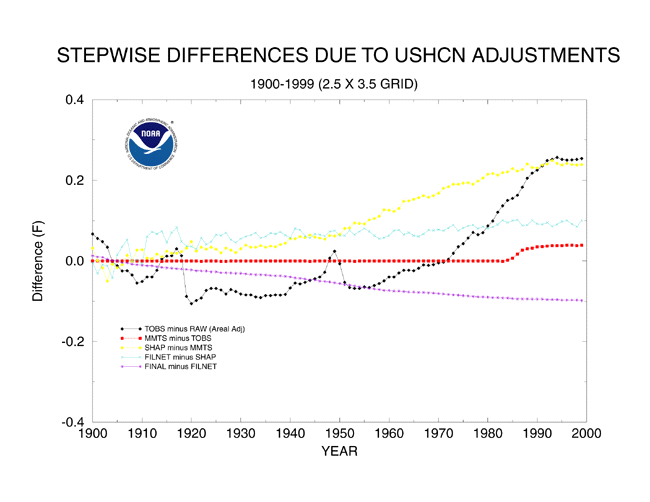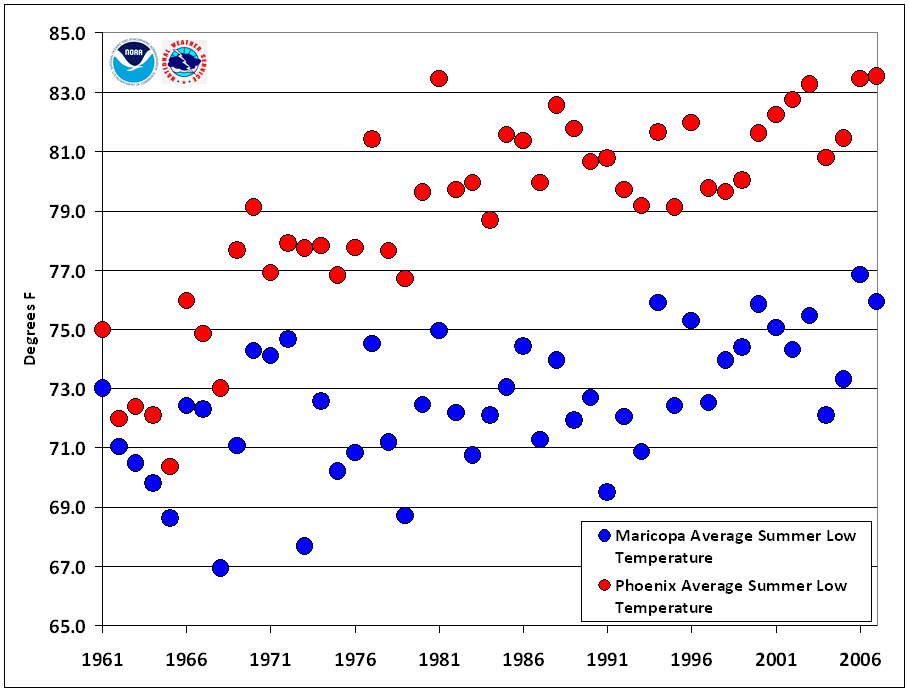When I ride my bicycle from an open space trail to the Safeway parking lot less than 100 yards away, I frequently see 5-10 degrees difference in temperature. Asphalt and snow removal make huge differences. The USHCN UHI adjustment is about 0.1 degrees F over the last century.
NOAA docs show 8F UHI in Phoenix, 80 times higher than what NCDC adjusts for.




This (neglect of UHI) more than any issue in the climate ‘debate’ truly p_sses me off.
The real deniers are those that ignore the massive effect of UHI.
The effect of UHI is upon the validity of the “global temperature” measurements, not upon the actual global mean temperature. This is what needs to be understood. Regular visitors to this site should know by now the measurements promulgated by climate scientists are completely insufficient for getting at the physical truth of the global mean surface temperature. In fact, with the fraudulent adjustments to the measurements, they are not just insufficient, they are not even just worthless; they are a lie, pure and simple, and that takes them completely outside the bounds of real science–which of course brings us right back to the understanding that the current “debate” is not about science, it is about the subversion of an incompetent science by scurrilous politicians, and the tyranny they wish to impose upon the people.
UHI can not be adjusted for! It is corrupted data and should be recorded as such and not used for historical records. TOBS is an admission the records are corrupted and worthless. Once an adjustment is made you are left with a “What-If Scenario” and not a temperature record. The Al-Gore-Rhythms used when building their temperature models make the results about equal to real world temperatures as http://www.revell.com/ is to real world automobiles.
I concur. This idea of adjustments is just guesswork polluted by bias. How do they know they are guessing right?
In the UK some homes have storage heaters. Bricks heated up by cheaper night time electricity to be released throughout the day. The city is one big storage heater.
Summer low temperatures?
I’m no expert, but my intuition says that, at least in moist climates, the greater UHI effect should be on the highs, in daytime, due to more pavement and fewer trees.
Maybe in AZ the higher humidity in developed areas causes a greater effect on temperatures at night?
The heat capacity of concrete and asphalt act like a temperature flywheel. They release most heat hours after the sun goes down.
When I was a younger man I worked at night. I used to have to close up every Friday and take a pack of invoices to the 24 hour express mail center at the airport. That’s about five miles one way.
On the way there, there were almost no stores, office buildings or parking lots, just trees and wide open fields. In the Winter the temperature would drop from around 10° to 1° before I made it into the cargo terminal.
Two weeks ago when the temperature dropped into the single digits at night I was very close to that area, only now every single tree has been cut down and there is nothing but industrial parks and massive parking lots for the greatly expanded airport.
I drove down the very same road for the hell of it and the temperature actually went up a degree in the same spot where it dropped by nine or ten degrees back in 1990.
Siting of thermometers is so important. Proximaty to trees, bodies of water and naturally to buildings, asphalt, gravel and such. Also even small depressions at night can be much cooler than relatively high areas. What is disgusting is that the same NOAA that “adjusts” data to suit their agenda also has control of station siting as well. Do you think they would site the stations “farily”? To pose the question is to answer it!
The NWS PHoenix report, below the chart(s) depicted in this article, noted plainly that the high temps were cooler than surrounding rural high temps:
That seems to negate the UHI theory for at least one city on the planet.
Your interpretation seems to negate your IQ